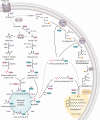Role of Wax Ester Synthase/Acyl Coenzyme A:Diacylglycerol Acyltransferase in Oleaginous Streptomyces sp. Strain G25
- PMID: 27474711
- PMCID: PMC5038041
- DOI: 10.1128/AEM.01719-16
Role of Wax Ester Synthase/Acyl Coenzyme A:Diacylglycerol Acyltransferase in Oleaginous Streptomyces sp. Strain G25
Abstract
Recently, we isolated a novel Streptomyces strain which can accumulate extraordinarily large amounts of triacylglycerol (TAG) and consists of 64% fatty acids (dry weight) when cultivated with glucose and 50% fatty acids (dry weight) when cultivated with cellobiose. To identify putative gene products responsible for lipid storage and cellobiose utilization, we analyzed its draft genome sequence. A single gene encoding a wax ester synthase/acyl coenzyme A (CoA):diacylglycerol acyltransferase (WS/DGAT) was identified and heterologously expressed in Escherichia coli The purified enzyme AtfG25 showed acyltransferase activity with C12- or C16-acyl-CoA, C12 to C18 alcohols, or dipalmitoyl glycerol. This acyltransferase exhibits 24% amino acid identity to the model enzyme AtfA from Acinetobacter baylyi but has high sequence similarities to WS/DGATs from other Streptomyces species. To investigate the impact of AtfG25 on lipid accumulation, the respective gene, atfG25, was inactivated in Streptomyces sp. strain G25. However, cells of the insertion mutant still exhibited DGAT activity and were able to store TAG, albeit in lower quantities and at lower rates than the wild-type strain. These findings clearly indicate that AtfG25 has an important, but not exclusive, role in TAG biosynthesis in the novel Streptomyces isolate and suggest the presence of alternative metabolic pathways for lipid accumulation which are discussed in the present study.
Importance: A novel Streptomyces strain was isolated from desert soil, which represents an extreme environment with high temperatures, frequent drought, and nutrient scarcity. We believe that these harsh conditions promoted the development of the capacity for this strain to accumulate extraordinarily large amounts of lipids. In this study, we present the analysis of its draft genome sequence with a special focus on enzymes potentially involved in its lipid storage. Furthermore, the activity and importance of the detected acyltransferase were studied. As discussed in this paper, and in contrast to many other bacteria, streptomycetes seem to possess a complex metabolic network to synthesize lipids, whereof crucial steps are still largely unknown. This paper therefore provides insights into a range of topics, including extremophile bacteria, the physiology of lipid accumulation, and the biotechnological production of bacterial lipids.
Copyright © 2016, American Society for Microbiology. All Rights Reserved.
Figures





References
-
- Heulin T, de Luca G, Barakat M, de Groot A, Blanchard L, Ortet P, Achouak W. 2012. Bacterial adaption to hot and dry deserts, p 69–86. In Stan-Lotter H, Fendrihan S (ed), Adaption of microbial life to environmental extremes—novel research results and application. Springer-Verlag, Vienna, Austria.
Publication types
MeSH terms
Substances
LinkOut - more resources
Full Text Sources
Other Literature Sources
Research Materials

